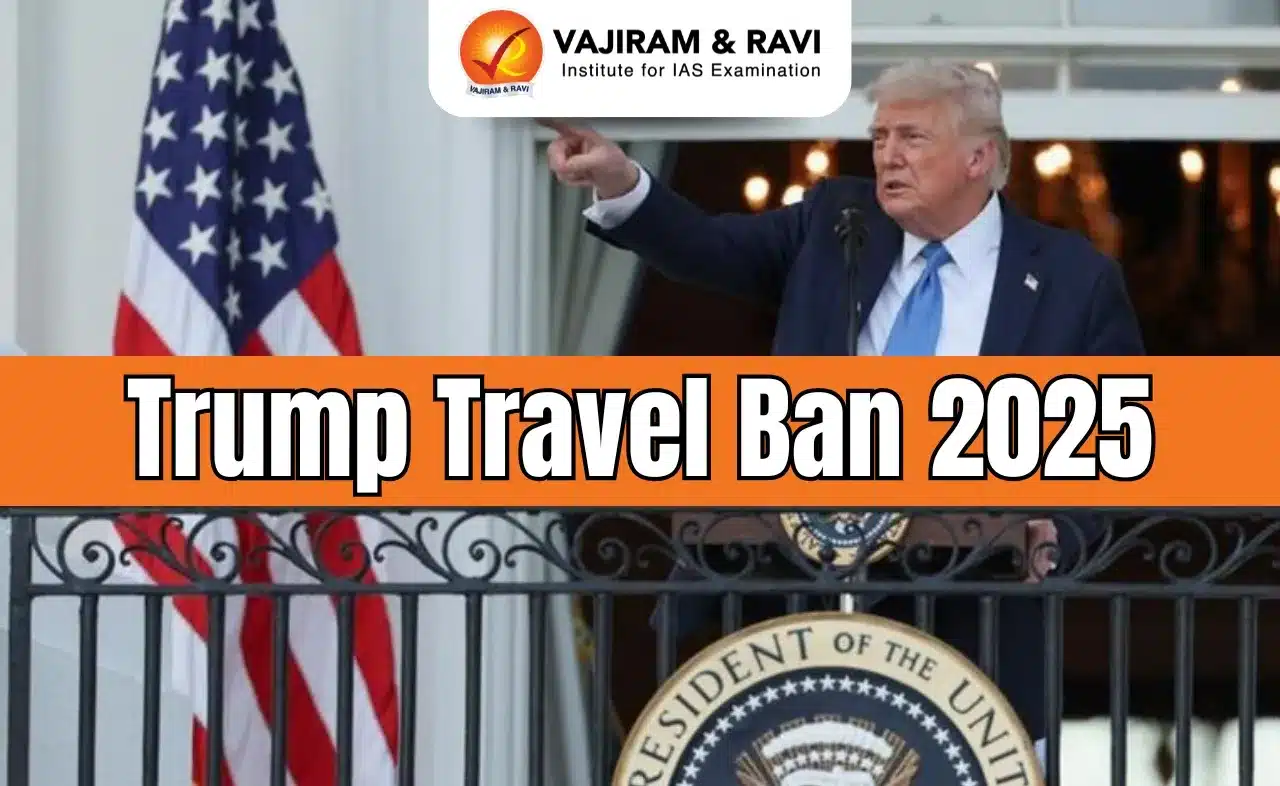Trump Travel Ban 2025 Latest News
- President Donald Trump, nearly five months into his second term, signed a new travel ban restricting entry from 12 countries and limiting visas for seven others.
- Aimed at reviving his earlier immigration agenda, the ban is intended to curb a possible surge in immigration. It will take effect at 12:01 am on June 9.
Travel Ban
- A travel ban is a U.S. federal policy that restricts or prohibits nationals from specific countries from entering the country.
- It may involve full entry bans or limitations on certain visa categories.
Trump’s Revived Policy
- President Trump’s latest order revives his first-term travel ban, with five previously affected countries reappearing in the new list.
Reason Behind the New Ban
- The new ban follows a deadly attack in Boulder, Colorado, allegedly by an Egyptian national.
- Though Egypt is not on the list, Trump used the incident to highlight the dangers of visa overstays and inadequate screening from certain countries.
New Travel Ban Under Trump
- The travel ban fully restricts entry for citizens from 12 countries. Partial restrictions apply to travellers from 7 Countries.
Purpose of the Ban
- The ban aims to encourage cooperation with each listed country, considering their “unique circumstances.”
- Countries may negotiate with the U.S. to ease restrictions, following a process similar to Trump’s trade negotiations.
Criteria for Inclusion
- Countries were included based on:
- Inadequate screening and vetting procedures
- High visa overstay rates
- Presence of terrorist actors or support for terrorism
- Refusal to accept deported nationals
Specific Allegations
- Iran and Cuba: Labeled state sponsors of terrorism
- Somalia: Called a terrorist safe haven
- Afghanistan: Identified as being controlled by the Taliban, a designated global terrorist group
- Haiti: Accused of sending “hundreds of thousands” of illegal migrants.
- Trump and VP JD Vance also made controversial and unverified claims about immigrants abducting pets.
Exemptions
- The ban does not apply to:
- Current visa holders
- U.S. permanent residents
- Dual nationals of banned countries traveling on a non-restricted passport
Precedents to the Travel Ban
- 2016 Campaign Rhetoric: Donald Trump called for a Muslim ban and a total and complete shutdown of Muslims entering the U.S., using inflammatory language such as Islam hates us.
- First Ban (January 2017): Banned citizens of seven Muslim-majority countries (Iran, Iraq, Libya, Somalia, Sudan, Syria, Yemen) for 90 days. It was overturned by a federal judge within a month.
- Second Ban (March 2017): Exempted green card and visa holders. Also blocked by federal judges.
- Third Ban (September 2017): Included Chad, Iran, Libya, North Korea, Somalia, Syria, Venezuela, Yemen. Upheld by the Supreme Court in June 2018. Chad was later removed after cooperation with the U.S.
- Fourth Ban (January 2020): Targeted immigrants (not tourists) from Eritrea, Kyrgyzstan, Myanmar, Nigeria, Sudan, and Tanzania.
- Biden’s Repeal (2021): President Joe Biden repealed all previous bans, calling them “a stain on our national conscience.”
Current Ban Is Different
- Broader Anti-Immigration Context
- Comes alongside Trump’s wider immigration crackdown in his second term—declaring a national emergency at the southern border, denying asylum, conducting raids, and limiting student admissions.
- Administrative Framing
- Unlike earlier bans, this one does not explicitly target Muslim-majority nations.
- Instead, it cites national security, overstay rates, terrorism links, and lack of cooperation from foreign governments.
- Legally More Cautious
- Legal experts suggest this ban is more likely to survive legal scrutiny.
- The delay in announcement suggests internal deliberation to bolster its legal standing.
- Focus on Implementation
- Experts warn the legality may ultimately depend on how fairly and consistently the policy is enforced.
Trump Travel Ban 2025 FAQs
Q1. What is the purpose of Trump’s new travel ban?
Ans. To curb immigration and encourage cooperation from countries with poor screening or high visa overstay rates.
Q2. Which countries are fully banned under the new order?
Ans. 12 countries including Afghanistan, Iran, Somalia, Sudan, Libya, and Yemen face full entry restrictions.
Q3. What makes this travel ban different from earlier ones?
Ans. It avoids focusing solely on Muslim-majority nations and cites broader national security concerns.
Q4. Are there exemptions under the new ban?
Ans. Yes, exemptions include visa holders, permanent residents, and dual nationals using non-restricted passports.
Q5. What legal strategy supports this version of the ban?
Ans. The administration used internal deliberation and broader criteria to help withstand legal challenges.
Last updated on December, 2025
→ Check out the latest UPSC Syllabus 2026 here.
→ Join Vajiram & Ravi’s Interview Guidance Programme for expert help to crack your final UPSC stage.
→ UPSC Mains Result 2025 is now out.
→ UPSC Notification 2026 is scheduled to be released on January 14, 2026.
→ UPSC Calendar 2026 is released on 15th May, 2025.
→ The UPSC Vacancy 2025 were released 1129, out of which 979 were for UPSC CSE and remaining 150 are for UPSC IFoS.
→ UPSC Prelims 2026 will be conducted on 24th May, 2026 & UPSC Mains 2026 will be conducted on 21st August 2026.
→ The UPSC Selection Process is of 3 stages-Prelims, Mains and Interview.
→ UPSC Result 2024 is released with latest UPSC Marksheet 2024. Check Now!
→ UPSC Prelims Result 2025 is out now for the CSE held on 25 May 2025.
→ UPSC Toppers List 2024 is released now. Shakti Dubey is UPSC AIR 1 2024 Topper.
→ UPSC Prelims Question Paper 2025 and Unofficial Prelims Answer Key 2025 are available now.
→ UPSC Mains Question Paper 2025 is out for Essay, GS 1, 2, 3 & GS 4.
→ UPSC Mains Indian Language Question Paper 2025 is now out.
→ UPSC Mains Optional Question Paper 2025 is now out.
→ Also check Best IAS Coaching in Delhi
Tags: mains articles trump travel ban 2025 upsc current affairs upsc mains current affairs


















